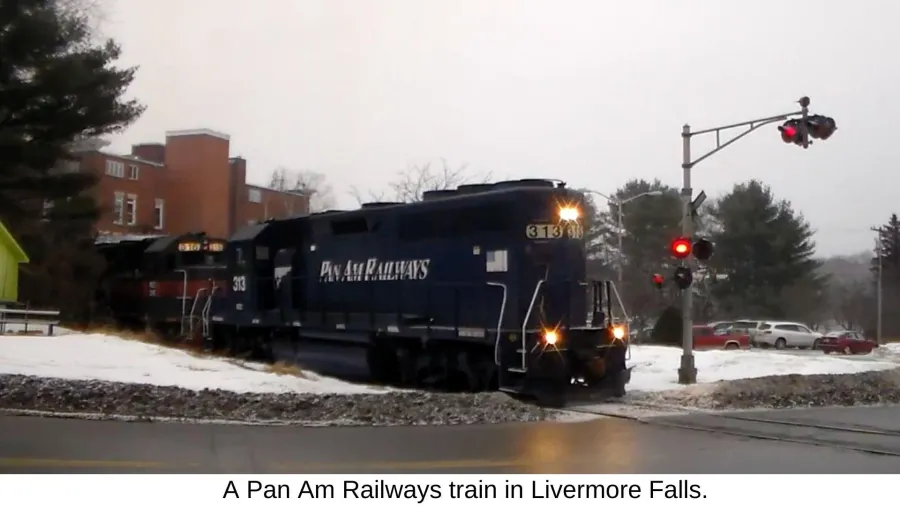Railroad Conductors & Engineers (SMART 1400) Affiliate with Maine AFL-CIO

The union representing train conductors and engineers in Central and Southern Maine has just affiliated with the Maine AFL-CIO. Train conductor Chris Lawrence, the chairman of the International Association of Sheet Metal, Air, Rail and Transportation Workers (SMART) Local 1400, said he has long been interested in affiliating with the state federation, but was determined to pull the trigger after we helped support the local’s efforts to stop the outsourcing of union switching operations jobs to a non-union contractor at the Rumford paper mill.
Lawrence then began attending Southern Maine Labor Council meetings where he met a leader of another railroad union and has since connected with union members at the Sappi Somerset mill to make preparations for his members to avoid crossing the picket line in the event of a strike there.
“I really appreciate what the Maine AFL-CIO is doing. It unifies unions and helps facilitate communication between locals throughout the state. Being members of a union federation builds a union culture in the state and strengthens all unions by bringing us together,” said Lawrence. “The Maine AFL-CIO is always there to provide workers like us assistance with communications, logistics, state and federal legislation and organizing. It’s just really important for us to have it as a resource.”
Lawrence grew up in Solon and started work for Pan Am Railways back in 2001 after a childhood friend recommended that he give it a try. The company owns about 1200 miles of track from Mattawamkeag north of Lincoln in Penobscot County through New Hampshire and Lowell, Massachusetts to upstate New York. Freight service runs through South Portland, Lewiston and Waterville with a branch that goes out through North Leeds to the Jay and Rumford paper mills. It hauls in liquid petroleum gas, chemicals for paper making from out of state and ships out finished paper products, Poland Springs water and lumber from timber companies in Northern Maine.
The rail line itself traces its roots back to 1862 when the Maine Central Railroad was created through the merger of the Androscoggin and Kennebec Railroad and the Penobscot Railroad to the Portland-Chicago mainline and Bangor and Piscataquis line. It also had a popular rail service for summer rusticators to sporting camps at Moosehead and up and down the coast.
The Brotherhood of Locomotive Engineers Division No. 40 of Portland was one of the first unions organized in Maine in 1867, but there were also very militant railway strikes in Maine years earlier. Irish laborers were recruited to build the railroads throughout Maine in the 1840s and 50s. Brutally exploited for their labor, the Irish engaged in a number of strikes in those years, most notably in 1848 when a crew working on the line between Brunswick and Freeport resigned in solidarity with a fellow worker who was fired.
After the overseer retaliated by firing the whole crew, they got armed to prevent scabs from taking their jobs. It was reported that “guns, pistols, and ammunition were in great demand," and that "all the old arms in the neighborhood were purchased at any price.” As labor historian Charlie Scontras wrote, the strikers harassed the strike breakers, but no serious injuries were reported beyond that of one person who was shot in the leg.
In the 1870s there were frequent strikes on Maine railroads, including massive work stoppages on the Grand Trunk Railroad and and the Boston and Maine Railroad system over wages and scheduling. Railway men knew they had a great amount of leverage because they could shut down the movement of goods to demand better treatment, which is why state and local governments would often send out police and militias to break the strikes.
In response to the Boston and Maine Railroad strike of 1876, the Maine Legislature passed the first anti-strike “conspiracy law” aimed at the Brotherhood of Locomotive Engineers that resulted in the arrest of striking workers for the “obstruction of business on certain public corporations.” The labor strife in Maine was but a prelude to the massive Railroad Strike of 1877 when more than 100,000 workers went on strike nationwide, only to meet the violent hand of the state as 1,000 were jailed and some 100 were killed in the bloody uprising.
However, in the 20th century passenger service gradually ended, railway lines were discontinued and thousands of workers were laid off due to increased competition from trucking, buses and automobiles. In the early 1980s, Guilford Transportation Industries founder Timothy Mellon, the heir of a Pittsburgh banking family, purchased Maine Central and the bankrupt Boston & Maine rail lines. Railway workers were provoked into a bitter strike in 1986, in which the company deployed 500 strikebreakers and eliminated 3,000 strikers’ jobs by instituting new operating practices and more flexible work rules. The company was renamed Pan Am Systems in 2006 as it had purchased the bankrupt Pan Am Railways along with the name, colors and logo of the defunct airline in 1998.
Lawrence says the job of a freight conductor comes with many challenges, but the best parts of it are the good wages, health insurance and retirement that the union has fought for. Having seniority benefits in a union contract is critical because schedules are particularly grueling. Freight services run 24/7, so SMART 1400 members often work 16-hour days, overnights and on weekends.
"Many members are on call and are provided a two-hour notice requiring them to report for work, sometimes with an hour or more drive time. These calls can come at anytime,” he said. “Although we work in some pretty extreme conditions, being a year-round outdoor operation, much of the time it is the logistics of railroading that is the most difficult part. It takes much more in today's workforce environment to convince employees to work nights, weekends, and long hours. There are plenty of opportunities out there that don't include 16-hour days, hotel stays, and long cab rides."
These difficult schedules can also make it very difficult to keep a life/work balance to maintain family relationships.
"In the past, to meet these demands, most railroad families had a one worker household,” said Lawrence. “Today that is less so the case, as most households have both adults pursuing careers and raising their families. The rail industry nationwide has had trouble adapting to this new way of life and find it difficult to provide flexibility and stability for its employees."
Meanwhile, there’s also a lot of uncertainty for SMART 1400 members with the pending purchase of the business by Florida-based transportation company CSX. Their hope is this new employer will be able to provide a safer work environment and bigger financial incentives for SMART 1400 members.
“The railroads have had to create incentives for us to work just like everywhere else and it’s important to establish leverage in negotiations to make this occupation more appealing for new workers,” said Lawrence. “It feels like the last couple of years workers have really started to make people understand their value in the economy. This provides a great opportunity for a pro-union culture to flourish and open workers’ eyes to just how strong their voices can be if they stand together.”
